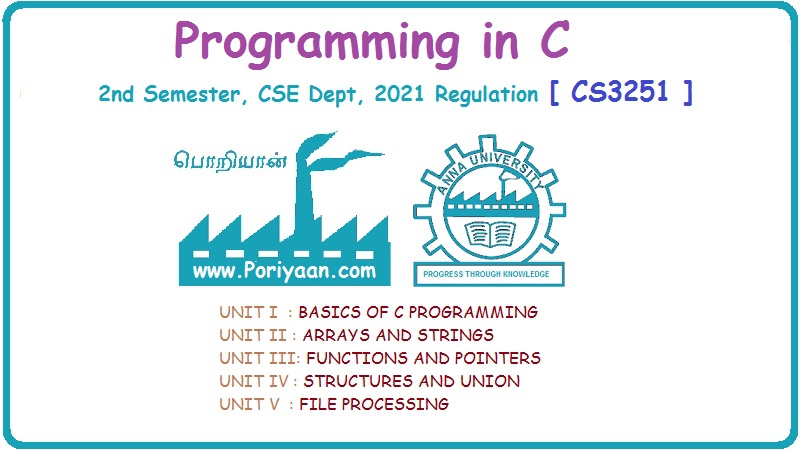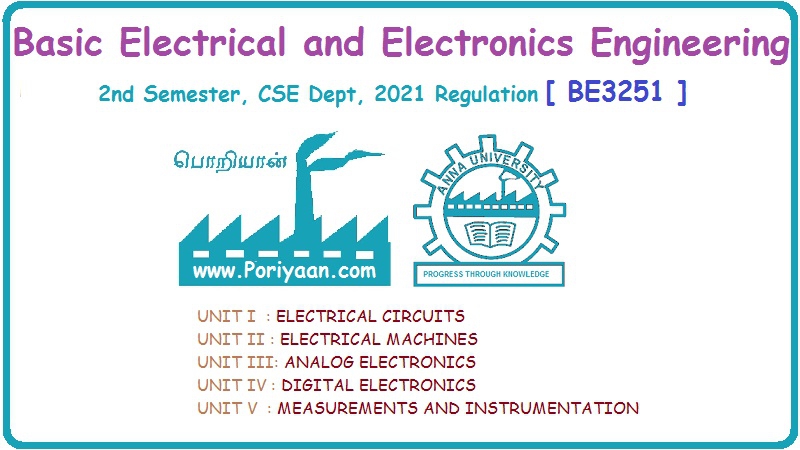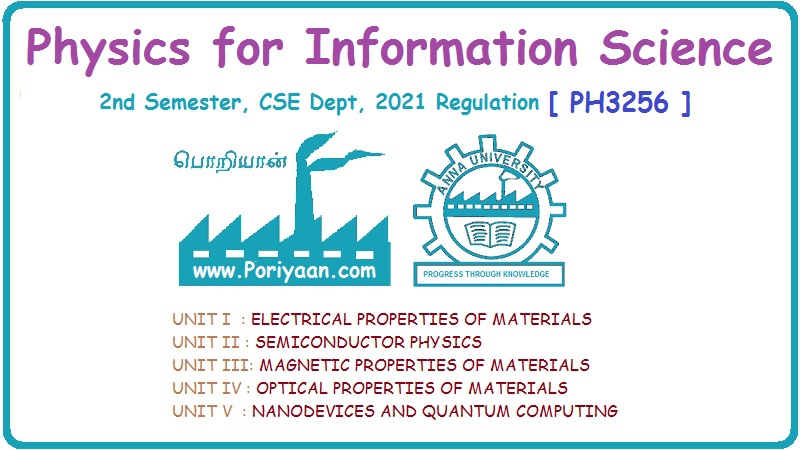Physics for Information Science
PH3256 2nd Semester CSE Dept | 2021 Regulation

2021 regulation - 1st year, 2nd semester paper for CSE Department (Computer Science Engineering Department). Subject Code: PH3256, Subject Name: Physics for Information Science, Batch: 2021, 2022, 2023, 2024. Institute: Anna University Affiliated Engineering College, TamilNadu. This page has Physics for Information Science study material, notes, semester question paper pdf download, important questions, lecture notes.
PDF Download Links
Physics for Information Science
- Introduction of Electrical Properties of Materials
- Electron Theory of Metals
- Classical Free Electron Theory of Metals
- Conduction in Metals-Mobility and Conductivity
- Expression for Electrical Conductivity
- Thermal Conductivity
- Expression for Thermal Conductivity
- Wiedemann - Franz Law and Lorentz Number
- Differences Between Electrical and Thermal Conductivity
- Similarities Between Electrical and Thermal Conductivity of Metals
- Success of Classical Free Electron Theory of Metals
- Failures of Classical Free Electron Theory
- Quantum Theory of Electrons in Metals
- Particle in a Three Dimensional Potential Box
- Degeneracy and Non-Degeneracy
- Fermi-Dirac Statistics
- Energy Distribution of Electrons in Metals
- Fermi Distribution Function
- Effect of Temperature on Fermi Function
- Density of Energy States and Carrier Concentration in Metals
- Electron in Periodic Potential
- Energy Spectra in Atoms, Molecules and Solids
- Bloch Theorem [for Reference Purpose]
- Behaviour of an Electron in a Periodic Potential -The Kronig Penney Model (Qualitative Treatment)
- Tight Binding Approximation
- Brillouin Zones
- Construction of Brillouin Zones
- Effective Mass of an Electron and Concept of Hole
- Effective Mass Approximation
- Energy Band Theory of Solids
- Origin of Energy Band Formation in Solids
- Classification of Materials into Metals, Semiconductors and Insulators on the Basis of Band Theory
- Introduction of Semiconductor Physics
- Properties of Semiconductor
- Direct and Indirect Band Gap Semiconductors
- Types of Semiconductors
- (i) Intrinsic Semiconductor
- Carrier Concentration in Intrinsic Semiconductors
- Variation of Fermi Energy Level and Carrier Concentration with Temperature in an Intrinsic Semiconductor
- Mobility and Electrical Conductivity of Intrinsic Semiconductors
- Determination of Band Gap Energy
- (ii) Extrinsic Semiconductor
- Carrier Concentration in n-Type Semiconductor
- Variation of Fermi Energy Level with Temperature and Impurity Concentration in 'n'-Type Semi Conductor
- Carrier Concentration in p-Type Semiconductor
- Variation of Fermi Energy Level with Temperature and Impurity Concentration in 'p' - Type Semiconductor
- Variation of Carrier Concentration with Temperature
- Carrier Transport in Semiconductor
- Velocity - Electric Field Relations and Mobility of Charge Carriers
- Drift and Diffusion Transport
- Einstein Relation [for Reference Purpose]
- Effect of Temperature on Carrier Transport
- Hall Effect
- Device to Find Hall Effect [Experiment]
- Applications of Hall Effect
- Ohmic Contact
- Schottky Diode
- Introduction of Magnetic Properties of Materials
- Basic Definitions - Magnetic Dipole Moment
- Magnetic Permeability and Susceptibility
- Classification of Magnetic Materials Based on Atomic Magnetic Moments
- Diamagnetic Material
- Paramagnetic Materials
- Ferromagnetic Materials
- Comparison Chart for Dia, Para and Ferro-Magnetic Materials
- Weiss Molecular Theory of Ferromagnetism Curie Temperature
- Spontaneous and Saturation Magnetisation
- Heisenberg Interpretation on Internal Field: (Quantum Theory)
- Ferromagnetic Domains
- Domain Theory of Ferromagnetism
- Hysteresis - M Versus H Behaviour
- Explanation of Hysteresis on the Basis of Domains
- Soft and Hard Magnetic Materials: Differences, Examples and Uses
- Energy Product
- Anti-Ferromagnetism
- Ferrimagnetism and Ferrites
- Structure of Ferrites
- Magnetic Moment of a Ferrite Molecule
- Applications of Ferrites
- Magnetic Principle in Computer Data Storage
- Magnetic Storage Devices
- Magnetic Tape
- Magnetic Hard Disk
- Magnetic Bubble Memories
- Magnetic Hard Disk Drive [HDD] with GMR Sensor
- Introduction of Optical Properties of Materials
- Classification of Optical Materials
- Carrier Generation and Recombination Processess
- Traps
- Colour Centres of Optical Properties of Materials
- Types of Colour Centres
- Optical Properties of Materials
- Optical Absorption in Metals
- Optical Absorption in Dielectrics (Insulators)
- Optical Absorption in Semi-Conductors
- Luminescence, Fluorescence and Phosporescence
- Photo-Electric Effect
- Photo Current in P-N-Junction Diode [Photo Diode]
- Solar Cell
- Light Emitting Diode (LED)
- Dome Shaped LED
- Organic Led [OLED]
- Laser Diode (GaAlAs-Laser)
- Optical Data Storage Techniques
- Data Storage in CD/DVD's
- Differences Between Magnetic Storage Devices and Optical Storage Devices
- Holography
- Differences Between a Photography and Holography
- Introduction of Nanodevices
- Electron Density in Bulk Material
- Size Dependence of Fermi Energy
- Quantum Confinement
- Quantum Structures
- Density of States (a) in Bulk Material (Three Dimension), Quantum Well (Two Dimensions)
- Band Gap on Nano Materials
- Tunneling
- Coulomb Blockade Effect
- Density of States (b) in Quantum Wire (One Dimension), Quantum Dot (Zero Dimension)
- Single Electron Phenomena and Single Electron Transistor
- Quantum Dot Laser [QD Laser]
- Conductivity of Metallic Nano Wires
- Ballistic Transport
- Quantum Resistance and Quantum Conductance
- Carbon Nanotubes [CNTS]
PDF Download Links
Physics for Information Science
Unit I: Electrical Properties of Materials
- Introduction of Electrical Properties of Materials
- Electron Theory of Metals
- Classical Free Electron Theory of Metals
- Conduction in Metals-Mobility and Conductivity
- Expression for Electrical Conductivity
- Thermal Conductivity
- Expression for Thermal Conductivity
- Wiedemann - Franz Law and Lorentz Number
- Differences Between Electrical and Thermal Conductivity
- Similarities Between Electrical and Thermal Conductivity of Metals
- Success of Classical Free Electron Theory of Metals
- Failures of Classical Free Electron Theory
- Quantum Theory of Electrons in Metals
- Particle in a Three Dimensional Potential Box
- Degeneracy and Non-Degeneracy
- Fermi-Dirac Statistics
- Energy Distribution of Electrons in Metals
- Fermi Distribution Function
- Effect of Temperature on Fermi Function
- Density of Energy States and Carrier Concentration in Metals
- Electron in Periodic Potential
- Energy Spectra in Atoms, Molecules and Solids
- Bloch Theorem [for Reference Purpose]
- Behaviour of an Electron in a Periodic Potential -The Kronig Penney Model (Qualitative Treatment)
- Tight Binding Approximation
- Brillouin Zones
- Construction of Brillouin Zones
- Effective Mass of an Electron and Concept of Hole
- Effective Mass Approximation
- Energy Band Theory of Solids
- Origin of Energy Band Formation in Solids
- Classification of Materials into Metals, Semiconductors and Insulators on the Basis of Band Theory
Unit II: Semiconductor Physics
- Introduction of Semiconductor Physics
- Properties of Semiconductor
- Direct and Indirect Band Gap Semiconductors
- Types of Semiconductors
- (i) Intrinsic Semiconductor
- Carrier Concentration in Intrinsic Semiconductors
- Variation of Fermi Energy Level and Carrier Concentration with Temperature in an Intrinsic Semiconductor
- Mobility and Electrical Conductivity of Intrinsic Semiconductors
- Determination of Band Gap Energy
- (ii) Extrinsic Semiconductor
- Carrier Concentration in n-Type Semiconductor
- Variation of Fermi Energy Level with Temperature and Impurity Concentration in 'n'-Type Semi Conductor
- Carrier Concentration in p-Type Semiconductor
- Variation of Fermi Energy Level with Temperature and Impurity Concentration in 'p' - Type Semiconductor
- Variation of Carrier Concentration with Temperature
- Carrier Transport in Semiconductor
- Velocity - Electric Field Relations and Mobility of Charge Carriers
- Drift and Diffusion Transport
- Einstein Relation [for Reference Purpose]
- Effect of Temperature on Carrier Transport
- Hall Effect
- Device to Find Hall Effect [Experiment]
- Applications of Hall Effect
- Ohmic Contact
- Schottky Diode
Unit III: Magnetic Properties of Materials
- Introduction of Magnetic Properties of Materials
- Basic Definitions - Magnetic Dipole Moment
- Magnetic Permeability and Susceptibility
- Classification of Magnetic Materials Based on Atomic Magnetic Moments
- Diamagnetic Material
- Paramagnetic Materials
- Ferromagnetic Materials
- Comparison Chart for Dia, Para and Ferro-Magnetic Materials
- Weiss Molecular Theory of Ferromagnetism Curie Temperature
- Spontaneous and Saturation Magnetisation
- Heisenberg Interpretation on Internal Field: (Quantum Theory)
- Ferromagnetic Domains
- Domain Theory of Ferromagnetism
- Hysteresis - M Versus H Behaviour
- Explanation of Hysteresis on the Basis of Domains
- Soft and Hard Magnetic Materials: Differences, Examples and Uses
- Energy Product
- Anti-Ferromagnetism
- Ferrimagnetism and Ferrites
- Structure of Ferrites
- Magnetic Moment of a Ferrite Molecule
- Applications of Ferrites
- Magnetic Principle in Computer Data Storage
- Magnetic Storage Devices
- Magnetic Tape
- Magnetic Hard Disk
- Magnetic Bubble Memories
- Magnetic Hard Disk Drive [HDD] with GMR Sensor
Unit IV: Optical Properties of Materials
- Introduction of Optical Properties of Materials
- Classification of Optical Materials
- Carrier Generation and Recombination Processess
- Traps
- Colour Centres of Optical Properties of Materials
- Types of Colour Centres
- Optical Properties of Materials
- Optical Absorption in Metals
- Optical Absorption in Dielectrics (Insulators)
- Optical Absorption in Semi-Conductors
- Luminescence, Fluorescence and Phosporescence
- Photo-Electric Effect
- Photo Current in P-N-Junction Diode [Photo Diode]
- Solar Cell
- Light Emitting Diode (LED)
- Dome Shaped LED
- Organic Led [OLED]
- Laser Diode (GaAlAs-Laser)
- Optical Data Storage Techniques
- Data Storage in CD/DVD's
- Differences Between Magnetic Storage Devices and Optical Storage Devices
- Holography
- Differences Between a Photography and Holography
Unit V: Nanodevices and Quantum Computing
- Introduction of Nanodevices
- Electron Density in Bulk Material
- Size Dependence of Fermi Energy
- Quantum Confinement
- Quantum Structures
- Density of States (a) in Bulk Material (Three Dimension), Quantum Well (Two Dimensions)
- Band Gap on Nano Materials
- Tunneling
- Coulomb Blockade Effect
- Density of States (b) in Quantum Wire (One Dimension), Quantum Dot (Zero Dimension)
- Single Electron Phenomena and Single Electron Transistor
- Quantum Dot Laser [QD Laser]
- Conductivity of Metallic Nano Wires
- Ballistic Transport
- Quantum Resistance and Quantum Conductance
- Carbon Nanotubes [CNTS]
PDF Download Links

PH3256
PHYSICS
FOR INFORMATION SCIENCE
COURSE OBJECTIVES:
•
To make the students understand the importance in studying electrical
properties of materials.
•
To enable the students to gain knowledge in semiconductor physics
•
To instill knowledge on magnetic properties of materials.
•
To establish a sound grasp of knowledge on different optical properties of
materials, optical displays and applications
•
To inculcate an idea of significance of nano structures, quantum confinement,
ensuing nano device applications and quantum computing.
UNIT I ELECTRICAL PROPERTIES OF MATERIALS
Classical
free electron theory - Expression for electrical conductivity – Thermal conductivity,
expression - Wiedemann-Franz law – Success and failures - electrons in metals –
Particle in a three dimensional box – degenerate states – Fermi- Dirac
statistics – Density of energy states – Electron in periodic potential – Energy
bands in solids – tight binding approximation - Electron effective mass –
concept of hole.
UNIT II SEMICONDUCTOR PHYSICS
Intrinsic
Semiconductors – Energy band diagram – direct and indirect band gap
semiconductors – Carrier concentration in intrinsic semiconductors – extrinsic
semiconductors - Carrier concentration in N-type & P-type semiconductors –
Variation of carrier concentration with temperature – variation of Fermi level
with temperature and impurity concentration – Carrier transport in
Semiconductor: random motion, drift, mobility and diffusion – Hall effect and
devices – Ohmic contacts – Schottky diode.
UNIT III MAGNETIC PROPERTIES OF MATERIALS
Magnetic
dipole moment – atomic magnetic moments- magnetic permeability and
susceptibility - Magnetic material classification: diamagnetism – paramagnetism
– ferromagnetism – antiferromagnetism – ferrimagnetism – Ferromagnetism: origin
and exchange interaction- saturation magnetization and Curie temperature –
Domain Theory- M versus H behaviour – Hard and soft magnetic materials –
examples and uses-– Magnetic principle in computer data storage – Magnetic hard
disc (GMR sensor).
UNIT IV OPTICAL PROPERTIES OF MATERIALS
Classification
of optical materials – carrier generation and recombination processes -
Absorption emission and scattering of light in metals, insulators and
semiconductors (concepts only) - photo current in a P-N diode – solar cell -
LED – Organic LED – Laser diodes – Optical data storage techniques.
UNIT V NANODEVICES AND QUANTUM COMPUTING
Introduction
- quantum confinement – quantum structures: quantum wells, wires and dots ––
band gap of nanomaterials. Tunneling – Single electron phenomena: Coulomb
blockade - resonant- tunneling diode – single electron transistor – quantum
cellular automata - Quantum system for information processing - quantum states
– classical bits – quantum bits or qubits –CNOT gate - multiple qubits – Bloch
sphere – quantum gates – advantage of quantum computing over classical
computing.
COURSE OUTCOMES:
At
the end of the course, the students should be able to
CO1: gain knowledge on classical and quantum electron theories, and energy band structures
CO2: acquire knowledge on basics of semiconductor physics and its applications in various devices
CO3: get knowledge on magnetic properties of materials and their applications in data storage,
CO4: have the necessary understanding on the functioning of optical materials for optoelectronics
CO5: understand the basics of quantum structures and their applications and
basics of quantum computing
TEXT
BOOKS:
1. Jasprit Singh, “Semiconductor Devices:
Basic Principles”, Wiley (Indian Edition), 2007.
2. S.O. Kasap. Principles of Electronic
Materials and Devices, McGraw-Hill Education (Indian Edition), 2020.
3. Parag K. Lala, Quantum Computing: A
Beginner's Introduction, McGraw-Hill Education (Indian Edition), 2020.
REFERENCES:
1. Charles Kittel, Introduction to Solid
State Physics, Wiley India Edition, 2019.
2. Y.B.Band and Y.Avishai, Quantum Mechanics
with Applications to Nanotechnology and
3. Information Science, Academic Press,
2013.
4. V.V.Mitin, V.A. Kochelap and
M.A.Stroscio, Introduction to Nanoelectronics, Cambridge Univ.Press, 2008.
5. G.W. Hanson, Fundamentals of
Nanoelectronics, Pearson Education (Indian Edition) 2009.
6. B.Rogers, J.Adams and S.Pennathur,
Nanotechnology: Understanding Small Systems, CRC Press, 2014.
Physics for Information Science: Unit I: Electrical Properties of Materials,, Physics for Information Science: Unit II: Semiconductor Physics,, Physics for Information Science: Unit III: Magnetic Properties of Materials,, Physics for Information Science: Unit IV: Optical Properties of Materials,, Physics for Information Science: Unit V: Nanodevices and Quantum Computing 2nd Semester CSE Dept 2021 Regulation : PH3256 2nd Semester CSE Dept | 2021 Regulation Physics for Information Science


